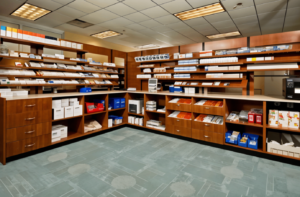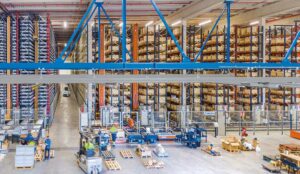Efficient storage is essential for businesses of all sizes, whether it’s a small startup or a large corporation. Proper storage strategies can help businesses optimize their warehouse space, improve productivity, and save costs. In this blog, we will discuss five efficient storage strategies that businesses can implement to maximize their storage capacity and enhance their overall operations, including utilizing self storage units for excess inventory or seasonal items.
From embracing vertical shelving solutions to implementing mobile storage options, we will explore various techniques that can make a significant impact on a business’s storage efficiency. Additionally, we will dive into techniques for maximizing available space, streamlining file organization for efficiency, and optimizing workspace for better storage.
By implementing these storage strategies, businesses can not only make the most of their storage space but also increase productivity, improve workflow, and save costs. So, let’s explore these strategies and find out how they can benefit businesses in various industries.
Five Space-Saving Strategies for Business Storage
To optimize storage space, businesses can implement five efficient storage strategies. These strategies include embracing vertical shelving solutions, implementing mobile storage options, utilizing available space, streamlining file organization, and optimizing workspace. By incorporating these strategies, businesses can maximize their storage capacity, improve efficiency, and save costs.
Strategy 1. Embracing Vertical Shelving Solutions
Vertical shelving solutions can be a game-changer when it comes to efficient storage. By utilizing the vertical space in a warehouse, businesses can significantly increase their storage capacity without expanding their square footage. Here are some key points to consider when embracing vertical shelving solutions:
- Utilize vertical racking systems that allow for stacking items vertically, maximizing storage capacity.
- Choose pallet racking systems that can be easily accessed with forklifts or other material handling equipment.
- Consider installing mezzanine floors to create additional storage space in the vertical dimension.
- Use vertical storage units or shelving systems with adjustable shelves to accommodate different-sized items.
By embracing vertical shelving solutions, businesses can make the most of their available space, increase storage capacity, and improve overall efficiency in their warehouse operations.
Strategy 2. Implementing Mobile Storage Solutions
Mobile storage solutions offer flexibility and compactness, making them an excellent option for businesses looking to optimize their storage space. These solutions involve the use of storage units that can be easily moved and rearranged within a warehouse, allowing for efficient loading and unloading of bulky equipment. Here are some key points to consider when implementing mobile storage solutions:
- Invest in mobile storage units or shelving systems that can be easily moved and reconfigured to accommodate changing storage needs.
- Utilize warehouse space more efficiently by storing items in compact storage units that can be easily maneuvered.
- Consider using storage units with built-in functionality, such as drawers or compartments, to maximize space utilization.
- Implement mobile storage solutions that allow for easy access to stored items, minimizing the time spent searching for specific items.
By implementing mobile storage solutions, businesses can maximize their storage capacity, improve accessibility to stored items, and optimize their warehouse space for better efficiency.
Strategy 3. Techniques for Maximizing Available Space
Maximizing available space is crucial for businesses looking to optimize their storage capacity. By utilizing every inch of space effectively, businesses can make the most of their warehouse storage. Here are some techniques for maximizing available space:
- Use storage systems that are designed to utilize vertical space, such as tall shelving units or pallet racking systems.
- Arrange items in a way that minimizes wasted space, such as stacking items vertically or using smaller containers for smaller items.
- Utilize mezzanine floors or raised platforms to create additional storage space without expanding the warehouse’s square footage.
- Implement a strategic layout for the warehouse, ensuring that aisles and pathways are optimized for efficient movement and access to stored items.
By maximizing available space, businesses can increase their storage capacity, improve accessibility to stored items, and create a more organized and efficient warehouse environment.
Strategy 4. Streamlining File Organization for Efficiency
File organization is essential for businesses that deal with a large volume of documents and paperwork. An efficient file organization system can not only save space but also improve productivity and streamline workflow. Here are some techniques for streamlining file organization:
- Use filing cabinets or storage systems that are designed for efficient document storage, with features like multiple drawers and adjustable shelves.
- Implement a systematic filing system that categorizes documents based on relevance, importance, or other criteria.
- Utilize labeling systems to easily identify and locate specific documents, minimizing the time spent searching for files.
- Regularly review and purge outdated or unnecessary documents to free up space and maintain an organized filing system.
By streamlining file organization, businesses can maximize their storage capacity, improve document retrieval time, and create a more efficient workflow.
Strategy 5. Optimizing Workspace for Better Storage
Optimizing workspace is essential for businesses that want to maximize their storage capacity and create a more efficient work environment. By utilizing the available office space effectively, businesses can improve storage capacity and enhance productivity. Here are some techniques for optimizing workspace:
- Consider the layout and design of the office space to ensure that storage areas are strategically placed for easy access.
- Use smart furniture solutions that offer built-in storage options, such as desks with drawers or shelves.
- Utilize interior design techniques that maximize storage capacity, such as utilizing wall space for shelving or storage units.
- Implement a systematic approach to storage, ensuring that items are organized and stored in a way that maximizes space utilization.
By optimizing workspace, businesses can improve storage capacity, enhance productivity, and create a more organized and efficient work environment.
Deep Dive into Vertical Shelving
Vertical shelving is an efficient storage solution that maximizes storage capacity by utilizing the vertical space in a warehouse. By embracing vertical shelving options such as vertical racking systems and mezzanine floors, businesses can significantly increase their storage capacity for multiple SKUs without expanding their square footage. Let’s explore the benefits and considerations of vertical shelving in more detail.
Here are some key benefits of vertical storage:
- Increased storage capacity: By utilizing the vertical space in a warehouse, businesses can significantly increase their storage capacity without expanding their square footage.
- Cost savings: Vertical shelving allows businesses to make the most of their available space, reducing the need for additional warehouse space and potentially saving on rental costs.
- Improved workflow: Vertical storage systems allow for easy access to stored items, minimizing the time spent searching for specific items and improving overall workflow efficiency.
- Flexibility: Vertical shelving options such as adjustable shelves or mobile storage units offer flexibility and adaptability to changing storage needs.
By understanding the benefits of vertical storage, businesses can make informed decisions about implementing vertical shelving solutions in their warehouse operations.
Identifying the Right Shelving Units for Your Business
When considering vertical storage options, it’s essential to identify the right shelving units that suit your business’s needs. Here are some key factors to consider when selecting shelving units:
- Racking system: Choose a racking system that is suitable for your storage needs, such as selective racks, drive-in racks, or push-back racks. Each system has its own advantages and considerations.
- Pallet size and weight capacity: Determine the size of your pallets and their weight capacity to ensure that the selected shelving units can accommodate your inventory.
- Warehouse space: Consider the available warehouse space and layout when selecting shelving units, ensuring that they can fit within the allocated space.
- Storage options: Evaluate the storage options provided by different shelving units, such as adjustable shelves, drawers, or compartments, to ensure they meet your business’s requirements.
By considering these factors and conducting a thorough evaluation, businesses can identify the right shelving units that maximize storage capacity and optimize their warehouse space.
Mobile Storage Solutions Explored
Mobile storage solutions offer flexibility and compactness, making them an excellent option for businesses looking to optimize their storage space. By implementing mobile storage options, businesses can make the most of their available space and enhance overall efficiency. Let’s explore the benefits and considerations of mobile storage solutions in more detail.
Advantages of Mobile Storage in Businesses
Mobile storage solutions offer several advantages for businesses looking to optimize their storage space. Here are some key benefits of mobile storage:
- Flexibility: Mobile storage units can be easily moved and rearranged within a warehouse, allowing businesses to adapt their storage layout to changing needs.
- Compactness: Mobile storage units maximize storage capacity by utilizing available space more efficiently, making them ideal for businesses with limited warehouse space.
- Functionality: Mobile storage units often come with built-in functionality, such as drawers or compartments, allowing businesses to store and organize items more effectively.
- Accessibility: Mobile storage units provide easy access to stored items, minimizing the time spent searching for specific items and improving overall efficiency.
By leveraging the advantages of mobile storage, businesses can maximize their storage capacity, improve accessibility to stored items, and optimize their warehouse space for better efficiency.
Selecting Mobile Storage Solutions That Fit Your Needs
When choosing mobile storage solutions for your business, it’s essential to consider several factors to ensure they fit your specific needs. Here are some key considerations when selecting mobile storage solutions:
- Functionality: Evaluate the functionality offered by different mobile storage units, such as the number of drawers or compartments, to ensure they meet your business’s storage requirements.
- Compactness: Consider the size and dimensions of the mobile storage units to ensure they can fit within your available warehouse space.
- Storage capacity: Evaluate the storage capacity of different mobile storage units and ensure they can accommodate your inventory volume.
- Accessibility: Consider the ease of access to stored items when selecting mobile storage units, ensuring they provide efficient retrieval and storage processes.
By carefully evaluating these considerations, businesses can select mobile storage solutions that fit their needs, maximize storage capacity, and optimize their warehouse space for better efficiency.
Maximizing Your Business Space
Maximizing available space is crucial for businesses looking to optimize their storage capacity and create a more efficient work environment. By utilizing every inch of space effectively, businesses can make the most of their office space and enhance their overall productivity. Let’s explore some techniques for maximizing business space.
Creative Ways to Use Every Inch of Your Workspace
Maximizing workspace is essential for businesses that want to make the most of their available space. Here are some creative ways to use every inch of your workspace:
- Utilize vertical storage options, such as wall-mounted shelves or hanging storage, to free up floor space and maximize storage capacity.
- Use smaller containers or organizers within larger storage units to maximize space utilization and keep items organized.
- Implement a system for categorizing and storing items based on frequency of use, ensuring that frequently accessed items are easily accessible.
- Consider using smart furniture solutions that offer built-in storage options, such as desks with drawers or shelves, to maximize storage capacity.
- Utilize interior design techniques, such as using mirrors or light-reflecting surfaces, to create an illusion of more space.
By implementing these creative ways to use every inch of your workspace, businesses can maximize storage capacity, minimize clutter, and create a more organized and efficient work environment.
Using Smart Furniture to Save Space
Smart furniture solutions offer innovative ways to save space and maximize storage capacity in a workspace. Here are some ways businesses can use smart furniture to save space:
- Utilize desks with built-in drawers or shelves to store office supplies and reduce the need for additional storage units.
- Choose multi-functional furniture, such as ottomans or benches with hidden storage compartments, to provide seating and extra storage space.
- Opt for wall-mounted shelves or floating desks to free up floor space and create a more open and spacious work environment.
- Consider using stackable chairs or collapsible tables that can be easily stored when not in use, saving space in meeting rooms or conference areas.
- Use modular furniture systems that can be easily reconfigured to adapt to changing space needs, allowing businesses to make the most of their available space.
By utilizing smart furniture solutions, businesses can save space, increase storage capacity, and create a more efficient and organized workspace.
File Organization Techniques
Best practices in file organization involve utilizing tools and software tailored for efficient management. Implementing a systematic approach aligned with the Pareto Principle optimizes storage capacity. Categorizing documents by frequency of use streamlines retrieval. Utilize smaller containers for active inventory and larger ones for archive storage. Maintain visibility and accessibility by labeling effectively. Incorporating interior design elements like layout and width improves functionality. Incorporate digital solutions for enhanced organization and accessibility within your storage area.
Best Practices for Efficient File Management
Efficient file management is crucial for businesses looking to optimize storage space and improve productivity. Here are some best practices for efficient file organization:
- Implement a systematic filing system that categorizes documents based on relevance, importance, or other criteria.
- Use file cabinets or storage systems with multiple drawers and adjustable shelves to maximize storage capacity.
- Utilize labeling systems to easily identify and locate specific documents, minimizing the time spent searching for files.
- Regularly review and purge outdated or unnecessary documents to free up space and maintain an organized filing system.
- Implement digital file management systems to reduce physical storage needs and improve accessibility to documents.
By following these best practices for efficient file management, businesses can maximize their storage capacity, improve document retrieval time, and create a more efficient workflow.
Tools and Software for Better File Organization
Technology can play a crucial role in improving file organization and optimizing storage capacity. Here are some tools and software that businesses can use for better file organization:
- Document management systems: These systems provide a centralized platform for storing, organizing, and retrieving documents, reducing the need for physical storage space.
- Optical character recognition (OCR) software: OCR software converts physical documents into searchable and editable digital files, streamlining document retrieval and reducing the need for physical storage.
- Cloud storage services: Cloud storage allows businesses to store and access documents remotely, eliminating the need for physical storage space and providing flexibility and scalability.
- Collaboration tools: Collaboration tools facilitate efficient file sharing and document collaboration, reducing the need for physical copies and improving document organization.
- Workflow automation software: Workflow automation tools automate document management processes, reducing manual handling and improving overall efficiency.
By leveraging these tools and software, businesses can enhance file organization, minimize physical storage needs, and improve overall document management processes.
Workspace Optimization Strategies
Optimizing workspace is essential for businesses looking to maximize their storage capacity and create a more efficient work environment. By utilizing every inch of space effectively, businesses can make the most of their office space and enhance their overall productivity. Let’s explore some strategies for workspace optimization.
Designing a Workspace That Promotes Efficiency
Designing a workspace that promotes efficiency is essential for businesses looking to maximize storage capacity and create an organized work environment. Here are some strategies for designing a workspace that promotes efficiency:
- Analyze workflow: Understand the flow of work and organize the workspace accordingly to minimize unnecessary movement and optimize productivity.
- Utilize ergonomic furniture: Choose furniture that promotes proper posture and comfort, reducing strain and fatigue among employees.
- Optimize layout: Arrange workstations, storage units, and common areas in a way that maximizes space utilization and facilitates easy access to resources.
- Use visual cues: Implement visual cues, such as color-coded labels or signage, to help employees easily locate and identify resources or areas within the workspace.
- Foster collaboration: Create spaces that encourage collaboration and communication among employees, promoting a more efficient and productive work environment.
By incorporating these strategies, businesses can optimize their workspace, maximize storage capacity, and improve overall efficiency in their operations.
Implementing Smart Storage Solutions in the Workplace
Implementing smart storage solutions in the workplace can significantly improve storage capacity and efficiency. Here are some ways businesses can implement smart storage solutions:
- Utilize modular storage systems that can be easily reconfigured to adapt to changing storage needs.
- Implement storage solutions with adjustable shelves or compartments to accommodate different-sized items.
- Use rolling carts or mobile storage units that can be easily moved and rearranged as needed.
- Consider utilizing vertical storage options to make the most of available space.
- Implement digital storage solutions, such as cloud-based document management systems, to reduce physical storage needs and improve accessibility to stored information.
By implementing smart storage solutions, businesses can optimize their storage capacity, improve workflow efficiency, and create a more organized and efficient work environment.






